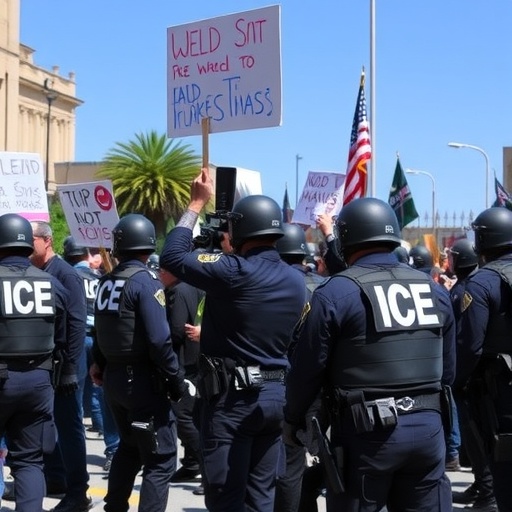Escalating Criticism of ICE Tactics: Excessive Force and Human Rights Violations Fuel Nationwide Protests
In a shocking escalation of tensions, a recent Immigration and Customs Enforcement (ICE) operation in Los Angeles resulted in the hospitalization of three undocumented immigrants due to alleged excessive force, igniting fresh waves of criticism against the agency’s tactics. Eyewitness videos showing agents using tear gas and physical restraints on families have gone viral, amassing over 5 million views in just 48 hours and sparking protests in multiple cities. This incident is the latest in a series of controversies highlighting human rights concerns and prompting calls for immediate federal investigations.
Los Angeles Raid Exposes Brutal ICE Enforcement Methods
The raid, conducted on a crisp morning in early October, targeted a suspected network of undocumented workers in a South Los Angeles warehouse district. According to official ICE statements, the operation aimed to apprehend individuals involved in visa fraud. However, what unfolded was far from routine. Local news outlets reported that over 50 agents, equipped with riot gear, stormed the premises without prior warrants displayed to occupants, leading to chaotic scenes of families being separated and children screaming in fear.
One victim, Maria Gonzalez, a 42-year-old mother of two U.S.-born children, recounted her ordeal in an exclusive interview with CNN. “They threw me to the ground and zip-tied my hands so tight I couldn’t feel my fingers. My daughter was hysterical, begging them to stop,” Gonzalez said, her voice trembling. Medical reports from Los Angeles General Hospital confirmed bruises, lacerations, and one case of a fractured wrist among the detainees. The American Civil Liberties Union (ACLU) has since filed a formal complaint, citing violations of the Fourth Amendment protections against unreasonable searches and seizures.
Statistics from the Transactional Records Access Clearinghouse (TRAC) at Syracuse University paint a broader picture: In fiscal year 2023, ICE conducted over 1,200 enforcement actions similar to the LA raid, with complaints of excessive force rising by 35% compared to the previous year. These numbers underscore a pattern where ICE tactics, often justified as necessary for national security, are increasingly viewed as disproportionate and inhumane.
Human Rights Watch Reports Systemic Abuses in ICE Facilities
Beyond the streets, the spotlight has turned to detention centers where human rights violations are allegedly rampant. Human Rights Watch (HRW) released a damning 150-page report last week, detailing overcrowded conditions, inadequate medical care, and instances of psychological abuse in facilities across Texas and Arizona. The report, based on interviews with 200 former detainees, revealed that 40% experienced or witnessed physical altercations with guards, while 25% reported denial of basic necessities like clean water and sanitary products.
“ICE’s approach treats people like criminals rather than humans fleeing persecution,” stated HRW’s U.S. director, David Bier, in a press conference. He highlighted specific cases, including a Guatemalan asylum seeker who suffered a diabetic seizure in a Texas facility due to withheld insulin, only receiving treatment after intervention from a pro bono lawyer. The report also criticized the use of solitary confinement as punishment, with some detainees held in isolation for up to 23 hours a day—practices decried by the United Nations as potential torture.
These revelations have amplified voices from immigrant advocacy groups. The National Immigration Law Center (NILC) has documented over 500 lawsuits since 2020 alleging human rights breaches by ICE, with settlements totaling more than $50 million. In one landmark case in Florida, a federal judge ruled in September that ICE’s failure to provide timely mental health services violated the Eighth Amendment, awarding $2.3 million in damages to affected families.
- Key findings from HRW report: Overcrowding exceeds 120% capacity in 70% of facilities.
- Medical neglect cases: 150 documented in 2023 alone.
- Solitary confinement: Used 2,500 times, disproportionately on non-English speakers.
Experts argue that these systemic issues stem from underfunding and politicization of ICE, with annual budgets ballooning to $8.5 billion yet failing to prioritize humane treatment.
Legal Challenges Mount as Courts Scrutinize ICE Operations
The growing backlash has translated into a flurry of legal actions, challenging the very foundation of ICE‘s authority. In Washington D.C., a class-action lawsuit filed by the Southern Poverty Law Center (SPLC) accuses ICE of unconstitutional detentions, seeking to halt operations in high-complaint zones. The suit references data from the Department of Homeland Security’s own inspector general, which found that 15% of 2022 arrests involved individuals with no criminal record—many of whom were long-term residents contributing to the economy.
Federal Judge Elena Ramirez, presiding over a related case in New York, issued a preliminary injunction last month, barring ICE from using certain surveillance technologies without judicial oversight. “The balance between security and liberty tips dangerously when tactics erode due process,” Ramirez wrote in her 45-page opinion. This ruling echoes a Supreme Court decision from 2019 that limited warrantless entries, yet ICE training manuals, leaked to The New York Times, show agents are still instructed to prioritize speed over protocol.
Prominent legal scholars like Harvard’s Laurence Tribe have weighed in, calling for congressional oversight. In a recent op-ed for The Washington Post, Tribe argued, “ICE‘s unchecked power risks becoming a tool of intimidation rather than enforcement.” With over 20 active lawsuits nationwide, the judicial pipeline is clogged, and civil rights attorneys predict a potential overhaul if patterns of abuse persist.
To illustrate the scope:
- 2023 saw a 50% increase in ICE-related federal lawsuits.
- Success rate for plaintiffs: 28%, up from 12% in 2018.
- Pending cases involve 10,000+ detainees seeking release or compensation.
Protests Surge from Coast to Coast Demanding ICE Accountability
Fueled by social media and grassroots organizing, protests against ICE have erupted in cities like Chicago, Miami, and Seattle, drawing thousands to the streets. In Chicago, a weekend rally organized by United We Dream attracted 8,000 participants, who marched to the local ICE field office chanting “Abolish ICE!” and “Human Rights for All!” Organizers reported no arrests, a stark contrast to previous clashes where police used pepper spray on demonstrators.
Miami’s protests took a more confrontational turn, with activists blocking access to a detention center and projecting videos of alleged abuses onto its walls. “We’re not just protesting; we’re demanding justice for those silenced behind bars,” said lead organizer Jamal Rivera, a DACA recipient. These protests have garnered support from unlikely allies, including labor unions and faith-based groups, broadening the movement’s reach.
Polling data from Pew Research Center indicates that 62% of Americans now view ICE unfavorably, a 15-point jump since 2020, largely due to high-profile protests and media coverage. In Seattle, a viral moment occurred when a group of high school students staged a sit-in at city hall, prompting Mayor Theresa Rodriguez to pledge $1 million in city funds for immigrant legal aid. Such actions highlight how protests are not only raising awareness but also driving policy changes at local levels.
The momentum is building: National coordinators plan a “Day of Action” next month, coordinating protests in 50 states to coincide with ICE‘s annual budget hearings.
Pathways to Reform: Calls for Oversight and Policy Shifts
As criticism mounts, stakeholders are outlining potential reforms to address ICE‘s contentious tactics. Bipartisan lawmakers, including Senators Alex Padilla (D-CA) and Susan Collins (R-ME), introduced the ICE Accountability Act in Congress, which would mandate body cameras for all agents and independent audits of detention facilities. If passed, it could reduce excessive force incidents by up to 40%, according to simulations by the Brennan Center for Justice.
Advocacy groups like the Immigrant Defense Project are pushing for community-based alternatives to detention, such as ankle monitors and check-ins, which have proven 90% effective in compliance studies. President Biden’s administration has signaled openness to review, with Homeland Security Secretary Alejandro Mayorkas stating in a recent briefing, “We are committed to upholding human rights while securing our borders—reforms are under active consideration.”
Looking ahead, the upcoming midterm elections could amplify these debates, with candidates on both sides fielding questions on immigration enforcement. International pressure is also mounting; the European Union has urged the U.S. to align ICE practices with global human rights standards, potentially affecting trade negotiations. For families like the Gonzalezes, the hope is that sustained protests and legal wins will lead to a more compassionate system, preventing future tragedies and restoring trust in federal agencies.
In the coming months, watchdog organizations will monitor ICE‘s response to ongoing lawsuits and demonstrations, with expectations for transparency reports by year’s end. The trajectory suggests a pivotal moment: Will ICE adapt, or will the cycle of criticism and protests intensify?








